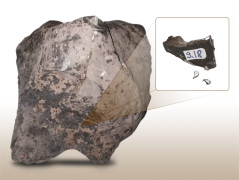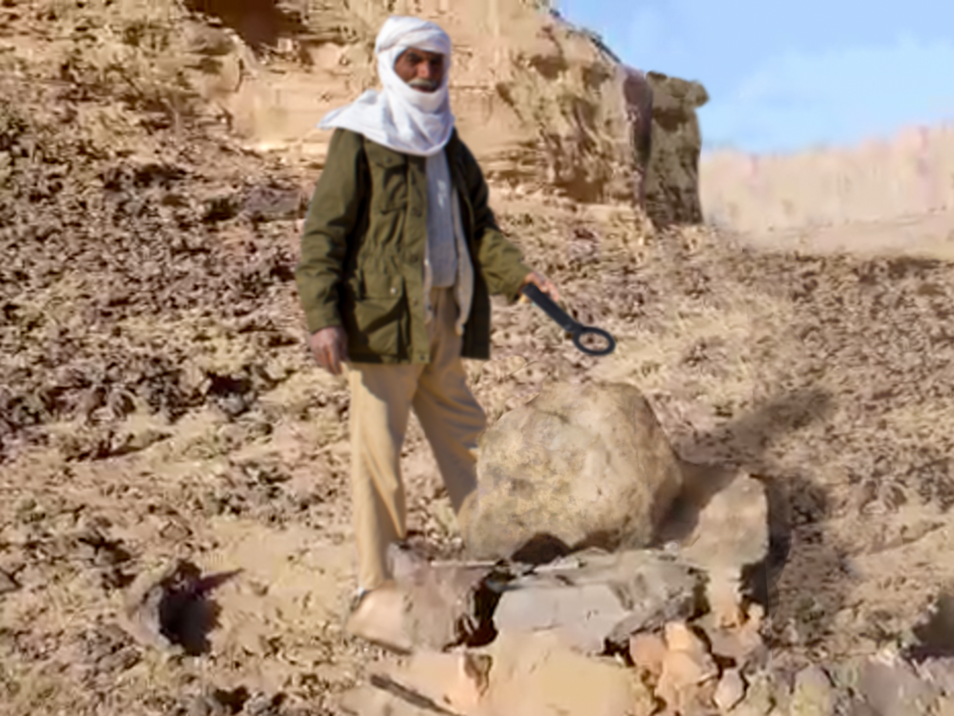MLZ is a cooperation between:
 > Technische Universität München
> Technische Universität München > Helmholtz-Zentrum Hereon
> Helmholtz-Zentrum Hereon
 > Forschungszentrum Jülich
> Forschungszentrum Jülich
MLZ is a member of:
 > LENS
> LENS > ERF-AISBL
> ERF-AISBL
MLZ on social media:

MLZ (eng)
Lichtenbergstr.1
85748 Garching
Everything extraterrestrial: How neutrons expose a meteorite
The fascination for meteorites is great, after all they come to earth from very far away and tell a story about the origin of our solar system. However, what the remarkable pieces of rock are about in detail only becomes clear after detailed analysis. Now neutrons of the Heinz Meier-Leibnitz Zentrum (MLZ) helped to uncover fragments of a meteorite from North Africa.
About 200,000 meteorites with a mass of more than 100 grams fall down to earth every year. Smaller extraterrestrial rocks are rained down by the ton, but most of them burn up. Many of the fallen meteorites remain undiscovered and weather. However, in deserts, both hot and cold, they can last for tens of thousands of years. There they are just waiting to be found by curious collectors.
Weighing half a ton, two meters deep in the ground
In the border area between Libya and Chad, in the middle of no man’s land, locals coincidentally came across an iron meteorite. They were actually looking for gold when their metal detector went off. They had to dig two metres deep to bring the finding to light. But it was not gold they uncovered there, but an alien rock. A proud half-ton weight. The meteorite is just under one metre long, 45 centimetres wide and 45 centimetres deep, reports Dieter Heinlein, a physicist from the DLR Fireball Network. The fact that the meteorite was buried so deep beneath the surface suggests that it fell from the sky a very long time ago, “possibly tens of thousands of years ago”, says Dr Xiaosong Li, instrument scientist at the Heinz Meier-Leibniz Centre (MLZ), who analyzed the material.
From North Africa to Upper Bavaria
The fact that it was something extraordinary was certainly also clear to the finders. They came to Heinlein through a mediator. As head of the Fireballs Network of the German Aerospace Center (DLR), meteorites are his specialty. The crucial question: Does the rock really have an extraterrestrial origin? Heinlein turned to the MLZ for an in-depth analysis. Thus a small piece of the large boulder found its way to Garching, to Dr. Xiaosong Li. It is not the first meteorite that came to his desk: About two years ago Li already examined the meteorite “Cloppenburg”.

Xiaosong Li analyzed a small splinter of the 500 kg heavy meteorite at the MLZ. © Reiner Müller / TUM
By pneumatics to the irradiation position
Li prepared samples for his investigation. Using a pair of pliers, he could easily separate small fragments of ten to 30 milligrams, that’s how soft the alien rock is. Neutron activation analysis was used to determine the elemental composition. Li irradiated the material in the rabbit irradiation system. “Rabbit irradiation” because the samples are shot pneumatically in small capsules through tubes to the irradiation position near the reactor core and back to the measuring laboratory, similar to an underground system rabbits build. Li measured the gamma radiation. It is characteristic for single chemical elements and thus provides information about the composition.
Definitely extraterrestrial
The result clearly reveals the extraterrestrial origin of the rock samples. An undoubted marker is the large quantity of iridium. Researcher Li puts the analytical findings into perspective: “In the sample we have 15,000 times more iridium than is common on Earth”. The metal is even scarcer than gold or platinum in the earth’s rock; only one part in a billion is its share in the earth’s crust. This is really the proverbial needle in a haystack.
Born between Mars and Jupiter
“The neutrons helped us to uncover this extraordinary find. Based on the composition we can conclude that it is an iron meteorite,” explains Li. It is characterized by an alloy of iron with nickel. The particularly high nickel content of 18 percent further classifies the extraterrestrial rock as an ataxite. Ataxites are a special class of iron meteorites. Iron meteorites probably originate from the core of former asteroids, which broke up in collisions in space and fell to earth in fragments. Most asteroids move between the orbits of Mars and Jupiter. The probability that this meteorite also has its origin there is therefore high. Iron meteorites make up only about one twentieth of all meteorites, ataxites are again a rare class. So the meteorite in Libya is an unusual find.
Baptized in the name of “Oiuru 001”
Heinlein and Li reported the results of the analysis to the Meteoritical Society. The organization assigns internationally recognized names to meteorites and publishes them in its bulletin and database. Usually meteorites bear the name of the place where they were found. Not so easy with this find in the no man’s land between the states. The Naming Committee of the Meteoritical Society finally named it “Oiuru 001”. This means that the meteorite is now officially recognized – as one of a total of 1499 meteorites in Libya.

Veronika Aechter
Press & Public Relations
FRM II
MLZ is a cooperation between:
 > Technische Universität München
> Technische Universität München > Helmholtz-Zentrum Hereon
> Helmholtz-Zentrum Hereon
 > Forschungszentrum Jülich
> Forschungszentrum Jülich
MLZ is a member of:
 > LENS
> LENS > ERF-AISBL
> ERF-AISBL
MLZ on social media:



